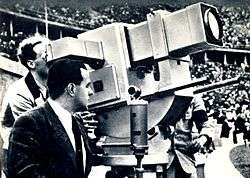180-line television system

The „Olympic-Cannon“ television camera at the 1936 Summer Olympics in Berlin, developed by Emil Mechau at Telefunken and operated by Walter Bruch (inventor of the PAL-system.)
180 lines (by modern standards it could be called 169p) is an early electronic television system. It was used in Germany after on March 22, 1935, using telecine transmission of film, intermediate film system, or cameras using the Nipkow disk. Transmissions using cameras based on the iconoscope began on January 15, 1936.
The Berlin Summer Olympic Games were televised, using both fully electronic iconoscope-based cameras and intermediate film cameras, to Berlin and Hamburg in August 1936. Twenty-eight public television rooms were opened for anybody who did not own a television set. After February 1937 this system was replaced by a superior 441-line system.
| System | Field frequency | Active picture | Field blanking | No. of broad pulses | Broad pulse width | Line frequency | Front porch | Line sync | Back porch | Active line time | Video/syncs ratio |
|---|---|---|---|---|---|---|---|---|---|---|---|
| 180 lines | 25 Hz | 169 lines | 11 lines | 1 per field | 200 µs | 4500 Hz | 2.2 µs | 20.0 µs | 2.2 µs | 197.8 µs | 75/25 |
External links
This article is issued from Wikipedia - version of the 2/9/2015. The text is available under the Creative Commons Attribution/Share Alike but additional terms may apply for the media files.